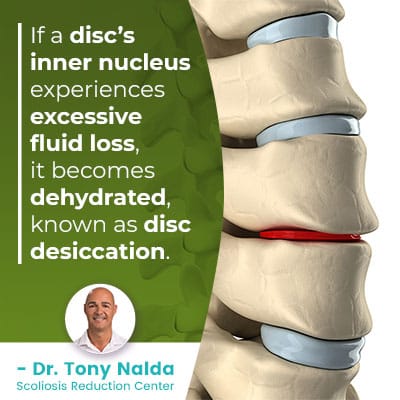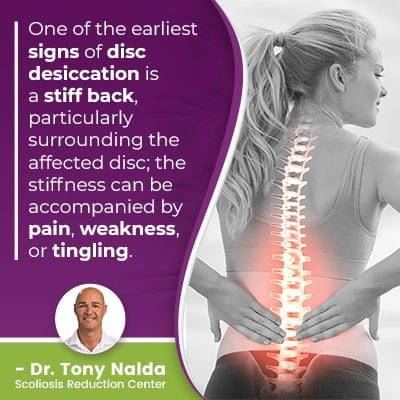What Is Disc Desiccation? Causes, Symptoms, and Treatment

The spine is made up of vertebrae (bones) that are stacked on top of one another in a straight and neutral alignment; an intervertebral disc sits between adjacent vertebrae, which they attach to. If an intervertebral disc moves or changes shape, it affects the vertebrae attached and the spine’s overall alignment and biomechanics.
The spine’s intervertebral discs perform many functions essential for optimal spinal health and function. When disc desiccation occurs, it means that a disc has experienced an excessive loss of its inner fluid, becoming dehydrated, which can lead to a change in its shape and disrupt spinal alignment.
Let’s start our discussion of disc desiccation with some basic spinal anatomy for a better understanding of how disc health affects spinal function.
Basic Spinal Anatomy
A healthy spine has rectangular-shaped vertebrae (bones of the spine) that are stacked on top of one another, and if the vertebrae stay in place, the spine can maintain its natural curves and alignment.
The spine is curved at each of its main sections: cervical (neck), thoracic (middle/upper back), and lumbar (lower back).
Part of the spine staying aligned is maintaining its natural curves, which make the spine stronger, and more flexible, and facilitate its even absorption/distribution of mechanical stress incurred during movement.
An intervertebral disc sits between adjacent vertebrae, and these discs perform a large number of functions key to spinal health: providing cushioning between adjacent vertebrae to reduce friction during movement, structural support as adjacent vertebrae attach to the disc in between, facilitating spinal flexibility, and acting as the spine’s shock absorbers.
As the discs perform so many important roles, they are generally the first spinal structure to show the effects of deterioration. Once that starts to happen, a number of problems can develop.
Now that we’ve covered some basic spinal anatomy, let’s take a closer look at the structure of the discs themselves.
Intervertebral Disc Structure
The spinal discs consist of two main components: a soft gel-like inner nucleus and a tough and durable outer annulus.
A disc’s outer portion protects its inner core, is tough, circular-shaped, and made of concentric sheets of lamellae (collagen fibers).
The inner nucleus is home to a network of fibers suspended in a mucoprotein gel. The annular fibers of the outer shell hydraulically seal and protect the gelatinous fluid within, while helping to evenly distribute force and pressure on the disc as a whole.
You can think of a disc as an outer and inner portion that fit together like concentric cylinders.
Each disc has cartilaginous end-plates on its outer annulus that adjacent vertebrae (spinal bones above and below) attach to, giving the spine structure.
When we’re born, the discs are made up of approximately 80 percent fluid, but as we age, the discs lose a certain level of hydration, and they need to stay hydrated to function properly.
Disc hydration is essential because its inner nucleus is the main bearer of the body’s axial load (force exerted on the spine), and the strength and flexibility of the nucleus depends on its level of hydration.
Now that we’ve explored some basic anatomy of the spine, and specifically the structure and role of its intervertebral discs, let’s move on to defining disc desiccation and how it occurs.
What is Disc Desiccation?
 As mentioned, at birth, the discs of the spine are largely made up of water, but fluid levels change as we age.
As mentioned, at birth, the discs of the spine are largely made up of water, but fluid levels change as we age.
If a disc’s inner nucleus experiences excessive fluid loss, it becomes dehydrated, known as disc desiccation.
Interestingly enough, the spinal discs are the largest structures in the body without their own vascular supply, meaning there is no direct path in and out of the discs through which nutrients can pass; nutrients are key to healing, restoration, and general disc health.
Disc desiccation is a condition that affects the cervical spine and can lead to various symptoms, including neck pain. It occurs when the discs between the vertebrae lose their natural moisture and become desiccated, resulting in a reduced ability to cushion and support the spine.
While disc desiccation itself is not typically considered serious, it can lead to other spinal issues like disc herniation as the disc material becomes more susceptible to damage.
Disc desiccation can lead to symptoms like stiffness and reduced mobility. Understanding the difference between disc desiccation and herniation is crucial for tailored treatment approaches. While desiccation refers to dehydration, herniation involves the protrusion of disc material. Although disc bulges can't typically be reversed, treatment options may include addressing disc space narrowing at the L5-S1 level and focusing on desiccation tolerance to manage symptoms effectively.
Multilevel disc desiccation involves the drying out of multiple discs in the cervical spine, potentially causing more widespread discomfort. Treatment for disc desiccation often focuses on managing symptoms, such as neck pain, through conservative approaches like physical therapy, pain management, or in some cases, surgical interventions may be considered. It's essential to consult with a healthcare professional for an accurate diagnosis and appropriate treatment plan based on individual circumstances.
Disc desiccation, such as cervical disc desiccation at C4-C5, refers to the drying out of spinal discs, which can lead to conditions like cervical degenerative disc disease, moderate disc desiccation with diffuse disc bulge, or a concentric disc bulge; unlike herniation, which involves a rupture, disc desiccation involves dehydration, and it can cause symptoms like spinal stenosis and pain in the lumbar spine, requiring treatment for pain relief and management of spinal cord pressure.
Disc desiccation is a condition where the intervertebral discs experience a loss of hydration, leading to symptoms like minor disc desiccation and diffuse disc desiccation. Imagine it as similar to how silica gel helps survive desiccation by absorbing water molecules. Understanding the causes and treatment options for extreme desiccation can be essential, much like preventing crop desiccation in agriculture.
Disc desiccation can cause lumbar disc degenerative disease; understanding the desiccation definition, symptoms, and treatment options, including whether a dehydrated disc can be cured and the potential need for spinal fusion surgery, is essential for effective management.
So once a disc reaches a certain level of desiccation, it can’t restore itself and increase that fluid level, not without help in the form of treatment, but first, let’s address causation.
What Causes Disc Desiccation?
In most cases of disc desiccation, it’s a feature of degenerative disc disease which is caused by the cumulative effect of wear and tear on the spine over time, related lifestyle choices, and less often, trauma.
While a certain amount of natural age-related disc degeneration is to be expected, negative lifestyle factors can increase those levels: repeatedly lifting heavy objects incorrectly, carrying excess weight, chronic poor posture, and leading a sedentary lifestyle.
Not understanding the ergonomics of how to lift heavy objects properly, particularly for those whose occupations demand it, can strain the spine and its discs over time and put it at risk of injury.
Chronic poor posture can wreak havoc on the spine by straining it and exposing it to adverse spinal tension.
Carrying excess weight puts added strains on all of the body’s joints, including the spine, and makes them work harder to absorb/distribute the body’s axial load.
Sudden weight loss can also be a contributing factor to disc desiccation as it can lead to the body, and its discs, losing fluid.
Disc desiccation refers to the dehydration or drying out of the intervertebral discs in the spine, a common occurrence in adults, particularly those with conditions like adult scoliosis. This process can result from various factors such as aging, spinal injuries, or degenerative diseases like osteoarthritis and osteoporosis. As the discs lose their hydration, they become less flexible and more prone to damage, leading to symptoms like back pain, stiffness, and reduced mobility.
Treatment options for disc desiccation often focus on managing symptoms and preventing further degeneration, including physical therapy, pain management techniques, and lifestyle modifications such as maintaining a healthy weight and proper posture. In severe cases, surgical interventions may be considered to address specific issues related to disc desiccation and alleviate symptoms.
The spine’s design is based on movement, so leading a sedentary lifestyle with lots of sitting and low activity levels can also lead to disc desiccation, and as the discs don’t have their own vascular supply, the only way they can replenish their fluid levels is through movement; if movement is lacking, the discs’ inner fluid levels can suffer.
In addition, not drinking enough water, over time, can also contribute to disc desiccation by lowering the body’s overall fluid level, and this includes its intervertebral discs.
When the spine experiences a significant trauma, like a fall, accident, or sports injury, it can also contribute to disc desiccation by simply damaging the spine.
While disc desiccation itself may not directly cause sciatica flare-ups, it can contribute to the compression of nearby nerves, potentially triggering sciatica symptoms. Understanding the causes and addressing disc desiccation can be essential in managing sciatica-related discomfort.
So now that we’ve defined the condition and what causes it, let’s talk about its symptoms.
Symptoms of Disc Desiccation
As there is a certain level of spinal degeneration and disc desiccation to be expected with age, not everyone will experience adverse symptoms or even be aware if disc desiccation is occurring, but if a disc’s inner-fluid level falls below a normal level, certain symptoms are common.
One of the earliest signs of disc desiccation is a stiff back, particularly surrounding the affected disc; the stiffness can be accompanied by pain, weakness, or tingling.
If the desiccated disc is in the lower back, numbness can develop, and depending on severity, the degree of nerve involvement, and the location of the affected disc, pain and numbness can radiate down the legs.
Some patients with disc desiccation also experience changes to their knee and foot reflexes.
So what should a person do if they are experiencing the symptoms mentioned above and receive a diagnosis of disc desiccation? How is it treated?
Treatment for Disc Desiccation
 If a patient’s disc desiccation is mild, often it’s lifestyle guidance that’s needed.
If a patient’s disc desiccation is mild, often it’s lifestyle guidance that’s needed.
Practicing proper posture, lifting objects correctly, losing weight, and developing a healthy activity level can all make improvements to disc health and function.
For patients whose symptoms are more noticeable and severe, here at the Scoliosis Reduction Center, I approach treatment with a conservative chiropractic-centered treatment approach that focuses on the combination of chiropractic care and in-office rehabilitation.
The effects of disc desiccation develop over time, so condition-specific chiropractic care focuses on reducing joint stress to induce structural changes.
I customize each and every treatment plan to address key patient/condition variables such as age and overall health, affected-disc location, and condition severity.
I would also help patients work towards strengthening their core muscles, so the spine is optimally supported and stabilized, also to help take pressure off the spine and its parts.
While it’s not always an easy process, with lifestyle changes and guidance on exercises for improving core strength, degenerative rates can be slowed, and fluid levels can be maintained.
In most cases, however, a full reversal of disc desiccation is only possible during the early stages of degeneration, and as the condition’s early signs are known to be subtle, it’s rarely diagnosed during the early stage.
It’s also important to note that just as the effects of disc degeneration are gradual and develop slowly over time, even if a full reversal is possible, it won’t be a quick and easy process.
Disc desiccation, a term frequently encountered in the realm of spinal health, refers to the process of dehydration or drying out of intervertebral discs. The condition can occur throughout the spine, with diffuse disc desiccation being a common manifestation. This phenomenon, often seen, for instance, in the l5-s1 region, can lead to a range of symptoms, including disc desiccation pain and potential nerve compression.
The desiccation process is part of the natural aging of the spine, where the discs lose moisture, height, and elasticity. While disc desiccation itself may not always cause noticeable symptoms, in some cases, it can contribute to conditions that result in pain and discomfort. Treatment approaches for l5-s1 disc desiccation may involve conservative methods such as physical therapy to improve spine flexibility and strength.
In more severe cases or when nerve compression becomes a significant concern, spinal fusion may be considered as a surgical option to address the underlying issues associated with disc desiccation and provide long-term relief. Understanding the causes, symptoms, and treatment options for disc desiccation is crucial for individuals navigating spinal health concerns.
Disc desiccation, a condition often linked to aging and disc desiccation, marked by the drying out of spinal discs, can manifest in symptoms similar to those of C5-C6 disc bulging and may contribute to conditions like spondylosis and retrolisthesis, with cervical and lumbar multilevel spondylosis often reflecting advanced stages; understanding and reversing degenerative disc disease is key to its management and treatment.
Disc desiccation, a condition involving the drying out of spinal discs, can lead to various symptoms and discomfort, potentially exacerbated by factors like retrolisthesis. Understanding its causes, symptoms, and treatment options is essential for managing this spinal issue effectively.
Conclusion
While a certain level of spinal degeneration and disc desiccation is to be expected with age, its effects can be minimized through proactive effort.
Disc desiccation, a condition characterized by the drying out or dehydration of intervertebral discs in the spine, can lead to various symptoms. Understanding the causes, symptoms, and treatment options for disc desiccation is crucial for managing this condition, even in cases where rotoscoliosis may be present.
Practicing a healthy lifestyle is key to preserving the spine’s overall health and function.
As the intervertebral discs play so many important roles in spinal function, they are often the first spinal structures to show the effects of deterioration.
When the discs of the spine start to experience a decrease in their inner-fluid levels, this process is known as disc desiccation and can impact the spine in terms of its overall health and function.
As a common element of degenerative disc disease, if left untreated, the spinal discs experience increased rates of deterioration, and additional spinal issues can develop due to the spine becoming misaligned.
The best way to avoid potential disc desiccation and slow the rate of natural spinal degeneration is prevention through healthy lifestyle choices: maintaining a healthy weight, activity level, staying hydrated, and avoiding straining the spine.
Dr. Tony Nalda
DOCTOR OF CHIROPRACTIC
After receiving an undergraduate degree in psychology and his Doctorate of Chiropractic from Life University, Dr. Nalda settled in Celebration, Florida and proceeded to build one of Central Florida’s most successful chiropractic clinics.
His experience with patients suffering from scoliosis, and the confusion and frustration they faced, led him to seek a specialty in scoliosis care. In 2006 he completed his Intensive Care Certification from CLEAR Institute, a leading scoliosis educational and certification center.
About Dr. Tony Nalda
 Ready to explore scoliosis treatment? Contact Us Now
Ready to explore scoliosis treatment? Contact Us Now





